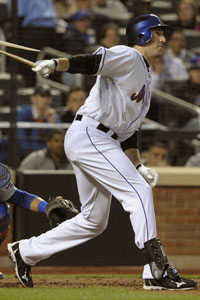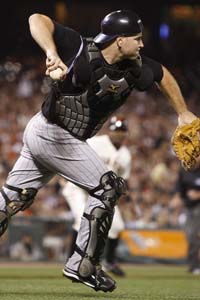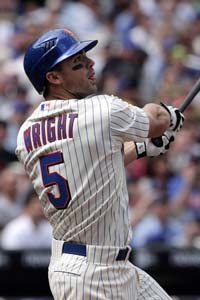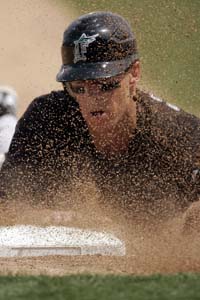Category: Dailies
Should you like Ike?
I like Ike.
Those three words are bound to be heard echoing around the confines of Citi Field in the months ahead, and if things go as New York Mets brass and fans hope, they could very well be heard coming out of the mouths of fortunate fantasy owners as well.
A 20-inning marathon win over the St. Louis Cardinals on Saturday night put into motion a series of events that resulted in the promotion of highly touted first-base prospect Ike Davis, a Mets first-round draft pick in 2008. The 23-year-old made an immediate impact in his Major League debut on Monday night, going 2-for-4 with an RBI in a 6-1 win over the Cubs.
 Long-term, Davis projects as a middle-of-the-order power bat, a player who could hit .290-.300 with 25-30 home runs and 90-100 RBI on a yearly basis. He’s drawn comparisons to John Olerud as a hitter and defender, but with greater power potential. Obviously, it would be asking a lot to expect that type of production out of him in his rookie season, but fantasy owners are not out of line to wonder if Davis can help them this year.
Long-term, Davis projects as a middle-of-the-order power bat, a player who could hit .290-.300 with 25-30 home runs and 90-100 RBI on a yearly basis. He’s drawn comparisons to John Olerud as a hitter and defender, but with greater power potential. Obviously, it would be asking a lot to expect that type of production out of him in his rookie season, but fantasy owners are not out of line to wonder if Davis can help them this year.
For one, at least in the immediate future, he’ll have the opportunity to play every day. Mets general manager Omar Minaya made it clear on Monday that Davis will not be part of a lefty-righty first-base platoon as Mike Jacobs, the man he’s replacing, was. With Daniel Murphy still not close to returning from a sprained ligament in his right knee, Davis can, at a minimum, be banked on for four at-bats every night.
Can he be productive with those four nightly at-bats? Everything he’s done over the past year indicates that he certainly can.
After struggling in short-season Single-A ball in Brooklyn during the summer of 2008, Davis rocketed up prospect lists in 2009 after hitting a combined .298 with 20 homers and 71 RBIs in 114 games between high-A St. Lucie and Double-A Binghamton in 2009. That production carried over to the Arizona Fall League, where he hit .341 with four homers and 16 RBIs in 21 games.
Davis’ phenomenal 2009 earned him an invite to big-league camp in Spring Training, where a .480-3-10 line in 12 games made him a familiar name for casual Mets fans and created a movement for him to begin the season in New York, one that gained steam following Murphy’s injury late in camp. Nonetheless, he began the season at Triple-A Buffalo, hitting .364 with two homers and three doubles in 33 at-bats while Mets first basemen hit a combined .188 with one homer and five RBIs in the team’s first 12 games.
Thus, when Jacobs was designated for assignment to make room for an extra bullpen arm following Saturday’s extra-inning victory, it made all too much sense to give a chance to a young man who’s done nothing but hit everywhere he’s been for the past year.
The elephant in the room here is, of course, Murphy, the Mets’ incumbent at first base and a player the team has been high on for several years. He may still be as much as a month away from returning, but his presence undeniably makes Davis a bit of a risk for fantasy owners. It’s tough to imagine the Mets sending Murphy back to the Minors, but also tough to imagine them taking the first-base job away from Davis should he perform well in Murphy’s absence.
For the time being, Davis is more than worth a roll of the dice. Who knows, you too may just like Ike.
The curious case of Chris Ianetta
Only eight catchers in all of baseball hit more home runs than Colorado Rockies catcher Chris Iannetta in 2009. Only 12 catchers had more RBIs than Iannetta in 2009. In 2008, only four catchers tallied more homers and only six drove in more runs.
Here’s the kicker — in each of those seasons, every player who bested Iannetta in home runs or RBIs did it in nearly 100, if not closer to 300, more at-bats.
 In 2008, Iannetta hit 18 homers and drove in 65 runs in just 333 AB. He followed that performance up by notching 16 dingers and 52 RBIs in a mere 289 AB last season. The numbers are a tantalizing taste of Iannetta’s power potential.
In 2008, Iannetta hit 18 homers and drove in 65 runs in just 333 AB. He followed that performance up by notching 16 dingers and 52 RBIs in a mere 289 AB last season. The numbers are a tantalizing taste of Iannetta’s power potential.
For comparison’s sake, Atlanta’s Brian McCann, who led National League catchers in home runs last year, went deep only five more times than Iannetta, despite receiving nearly 200 more AB. Joe Mauer led all catchers with 28 home runs in 2009. If given Mauer’s 523 AB, Iannetta’s home-run pace would have put him in line to match the total of the 2009 American League Most Valuable Player.
Throughout Iannetta’s rise through the Minor Leagues as a touted catching prospect and since his initial callup to the big leagues in 2006, there’s rarely been any doubt about the pop in his bat and his potential to be a run producer at the plate. What’s held him back is a lacking of playing time, specifically his inability to hold onto it when given opportunities. Iannetta entered both 2007 and 2009 as the Rockies’ Opening Day catcher and earned the starting job in the middle of 2008 as well, yet wound up ceding the top spot on the depth chart to Yorvit Torrealba each year.
Torrealba is no longer in Colorado, having signed with the Padres after the Rockies declined his 2010 option. The Rockies made an offseason commitment to Iannetta, signing him to a 3-year, $8.3 million extension. They also, however, brought Miguel Olivo into the fold following a season in which he notched 23 HR and 65 RBIs for Kansas City.
Iannetta won the starting job with a strong spring, hitting .350 with a homer and 10 RBIs in 40 AB. Olivo, however, was no slouch himself, hitting .318 with a homer and six RBIs. Two games into the regular season, history already seems on the verge of repeating itself, with a struggling Iannetta, hitless through those two contests, trying to hold off a proven veteran.
Iannetta was very slow out of the gate in his previous seasons as the Opening Day catcher, hitting just .158 through April in 2007 and only .174 through April in 2009. Obviously, two games hardly represent a fair sample size, but given Iannetta’s history, fantasy owners have to wonder whether or not another reduction to platoon or backup status is in the offing.
With Iannetta set to turn 27 on April 8 and entering his fifth big league season, the pressure is very much on him to make good on his promise. It’s clear that, given a full starter’s complement of at-bats, Iannetta has the potential to be an elite fantasy catcher. However, given Olivo’s presence and Iannetta’s track record, fantasy owners will have to role the dice on the Rockies’ catching situation.
Does David still have the Wright stuff?
Few players were as big a disappointment to fantasy owners a year ago as New York Mets third baseman David Wright.
After entering 2009 as one of the game’s premier young players and a seemingly mortal lock for 30-plus home runs and 100-plus RBIs, Wright stumbled to utterly shocking totals of 10 homers and 72 RBIs, by far the lowest marks he’s ever posted in a full season. It was a head-scratching power outage for a player who had become one of baseball’s most consistent performers. Though his .307 batting average was still dandy and his 27 stolen bases were a boon for his position, Wright was essentially reduced to a rather mediocre third baseman by fantasy standards.
 Heading into 2010, Mets insiders, outsiders, fans and fantasy owners alike have to wonder if Wright still has the right stuff.
Heading into 2010, Mets insiders, outsiders, fans and fantasy owners alike have to wonder if Wright still has the right stuff.
So far, the returns are very promising.
Wright went deep five times in 54 spring at-bats, a pace that would see him shatter his single-season high of 33 home runs should it carry over into the regular season. The 12 runs Wright drove in during the same period also represent a return to his career norm.
If that weren’t enough, Wright wasted little time in blasting his first homer of the regular season, launching a two-run shot off of Florida Marlins ace Josh Johnson in his first at-bat of the year. Perhaps more telling than the home run itself, however, was how it was hit.
After a year spent pulling looping fly balls to left field, Wright’s homer on Monday was a powerful drive to the opposite field. It was emblematic of the type of hitting that helped to initially make Wright a star. A smooth, level swing resulted in line drives all over the field, many of them carrying beyond the outfield fence. If his spring body of work was any evidence, the looping swing of a season ago, which resulted in a career high in strikeouts, seems to be gone, replaced by the old, familiar approach that’s seen Wright drive the ball with authority to the opposite field.
It’s also important to remember that Wright’s deflated RBI total in 2009 had a lot to do with the absence of Jose Reyes at the top of the Mets order. Reyes didn’t play a game after May last season while coping with knee and hamstring issues. Reyes’ return, expected to happen this weekend, should create plenty of run producing opportunities for Wright in the No. 3 spot of the Mets lineup.
So, what exactly sparked the change in approach that has seemingly fixed the four-time All-Star? It could be attributed to added muscle. Credit could also be given to Mets hitting coach Howard Johnson his offseason work with Wright. Perhaps it’s the combination of the two. Either way, what fantasy owners need to know is that the .300-30-100 Wright of old appears to once again dwell among us.
Coghlan still a key cog
A year ago, Florida Marlins outfielder Chris Coghlan snuck up on the entire National League, ultimately wrestling the NL Rookie of the Year Award away from Philadelphia Phillies left-hander J.A. Happ, Atlanta Braves right-hander Tommy Hanson and Pittsburgh Pirates center fielder Andrew McCutchen.
It was a shocker in the eyes of many. After all, although he hit for a robust .321 average, good for sixth in the NL, Coghlan flew well below the radar in comparison to his fellow rookies. While Happ emerged as a key cog for a World Series pitching staff and Hanson and McCutchen backed up their status as elite prospects, Coghlan toiled in relative obscurity in Florida. Despite solid numbers at nearly every level of the organization (.298 AVG, .839 OPS in 302 Minor League games), the 24-year-old converted infielder received little hype during his rise to the big leagues, and even less notoriety outside of Miami.
 Nonetheless, it appears someone took notice. Coghlan enters his second Major League season set to lead off for the Marlins while resuming his duties in left field. Coghlan showed very impressive plate discipline for a rookie, amassing 53 walks next to just 77 strikeouts in 565 at-bats, good for a .390 on-base percentage. Fantasy owners must be wondering, though, if he can not only repeat his rookie performance, but improve upon it. After all, an outfielder with a high AVG and OBP but little power numbers to go with them has a rather limited fantasy ceiling, and Coghlan’s nine home runs and 47 RBIs in 2009 are unquestionably well below average for a corner outfielder.
Nonetheless, it appears someone took notice. Coghlan enters his second Major League season set to lead off for the Marlins while resuming his duties in left field. Coghlan showed very impressive plate discipline for a rookie, amassing 53 walks next to just 77 strikeouts in 565 at-bats, good for a .390 on-base percentage. Fantasy owners must be wondering, though, if he can not only repeat his rookie performance, but improve upon it. After all, an outfielder with a high AVG and OBP but little power numbers to go with them has a rather limited fantasy ceiling, and Coghlan’s nine home runs and 47 RBIs in 2009 are unquestionably well below average for a corner outfielder.
There is, however, reason to believe that he can improve upon those totals in 2010. Coghlan’s 31 doubles and six triples in 2009 indicate that there is more pop to come in his bat, and a full season of experience against big league pitching should help him get his homer tally up over 15. It may be tough to dramatically increase his RBI total, particularly with a rather weak bottom of the order in Florida, but a full season in the leadoff spot, combined with a Minor League track record that suggests he’ll continue to reach base at a high clip, could do wonders for Coghlan in a couple of other areas.
After scoring 84 runs in 2009 — 76 of them in his 106 games as a leadoff hitter — it doesn’t seem out of the question for Coghlan to crack 100 runs in 150-plus games atop the Marlins lineup in 2010. That would have landed him in the Top 10 in runs scored in the NL in 2009. Coghlan’s mere eight stolen bases in 2009 were certainly a bit underwhelming, but after swiping 34 bags in Double-A in 2008, he certainly seems capable of netting 20-plus steals in the Florida leadoff spot.
For argument’s sake, a season consisting of a .300 AVG, an .825 OPS, 15 HR, 100 R, 30 2B, 6 3B and 20 SB would make Coghlan a very attractive fantasy option regardless of position. He could, however, develop truly tantalizing value should months’ worth of trade rumors ultimately result in Dan Uggla’s departure from Florida. A second baseman by trade, Coghlan would seemingly be the best option to take Uggla’s spot in the event of a trade, with top prospect Mike Stanton perhaps then getting a shot in left field.
Bottom line — don’t be afraid to take a chance on Coghlan the outfielder in 2010. You could ultimately wind up with an elite second baseman.
Finding value in unexpected places
I was a mixed bag of excitement and nerves when, as a young reporter, I got the call to interview Hall of Famer Paul Molitor.
The piece I was writing was beyond insignificant, no more than a short “where have they been since retirement?” feature. Nonetheless, the opportunity to pick the mind of a player I grew up idolizing had me positively giddy. I took extra care to research every detail of his career and life that I possibly could, and meticulously went over the wording of each one of my questions. I walked into The Baseball Center batting cages on Manhattan’s Upper West Side, the site of our interview and the unveiling of Molitor’s new batting glove, focused on ensuring that nothing would go wrong.
Twenty minutes later, I was laying on the floor inside a cage, clutching my leg as my knee throbbed in pain and cursing myself for buying into Molitor’s assurance that he, too, had not hit a hardball in years.
An errant foul tip while testing a pair of Molitor’s freshly endorsed gloves ultimately resulted in a torn MCL and dislocated patella in my right knee. At the time, however, my thoughts were focused not on my damaged knee, but on the panic settling in as I realized that I still had not had the chance to ask Molitor anything of value. I felt one of my biggest breaks slipping away from me.
It was then that the seven-time All-Star knelt down next to me and with a joking, “I’m glad that was you and not me,” gave me a hand to help me to my feet. I quickly realized that I could hardly put any weight on my right leg and could not bend my knee enough to get up the flight of stairs leading from the basement of the building to the street level. A hospital visit would surely be in order, but I had a quick decision to make — abandon the biggest opportunity of my young career, or hope my one good leg would hold out.
Needless to say, the choice was easy. Doing my best to hide my excruciating pain and freely moving kneecap (which ultimately came to rest on the right side of my knee), I picked Molitor’s mind on his approach to hitting, his fondest memories of his career, the sense of elation he had in finally winning his first World Series at the age of 36, how he managed to remain one of the game’s most effective hitters past age 40 and how he was passing his knowledge along to young hitters in both the professional and amateur ranks since hanging up his cleats. By the end of our conversation, my knee was entirely an afterthought. Until I had to find a way up those dastardly stairs, of course.
So, what does all of this have to do with fantasy baseball, you may ask? For one, it’s a reminder that knee-jerk reactions can cause damage that takes months to fully repair. Beyond that, it’s about finding value in unexpected places, something on which this blog will focus heavily. For me, that unexpected value was a defining moment coming from a seemingly low point in a young career. For you, it could be an under-the-radar move that turns a fantasy dud into a fantasy stud. So, slap on your knee brace and get ready to dig deep into the underbelly of the fantasy baseball world.